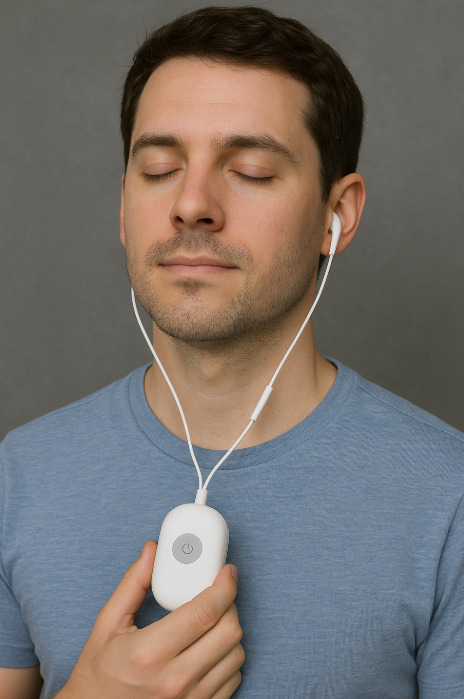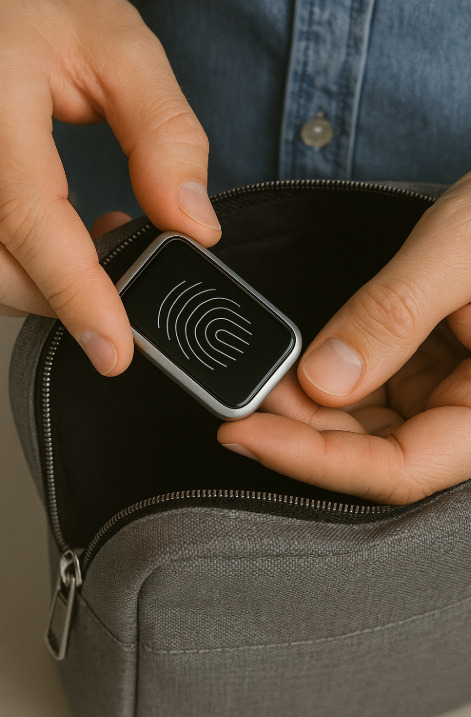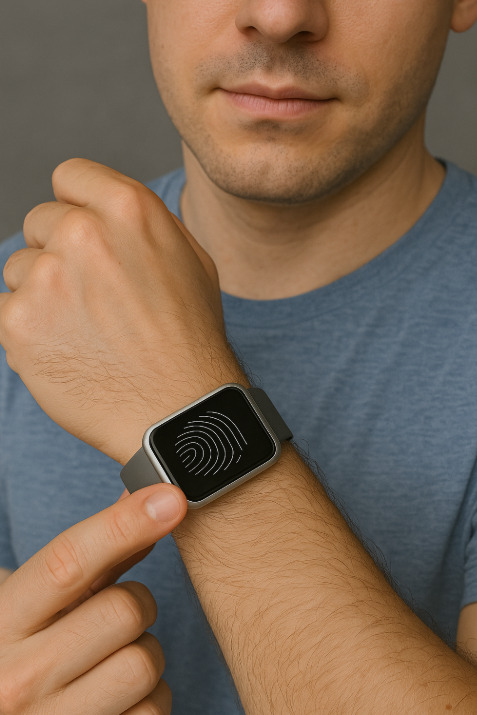Discover VeRelief by Hoolest Inc., a scientifically-backed, non-invasive solution for stress relief, better sleep, and enhanced performance. Our innovative vagus nerve activation technology helps you stay calm, focused, and relaxed—anytime, anywhere.
Don't wanna be here? Send us removal request.
Text
Vagus Nerve Stimulation Device: A Non-Medication Approach to Better Sleep and Focus

Sleep troubles hit hard. Lying awake at 2 AM. Mind won't shut off. Then struggling through the next day in a fog. Focus disappears when deadlines loom. Coffee helps for an hour, then makes things worse.
Millions of people deal with this cycle. Sleep medications help some but often leave users groggy. Stimulants provide temporary focus but crash later. Side effects pile up. Dependency becomes a concern.
There's another path emerging from medical research. The vagus nerve - a major communication line between brain and body - holds keys to better sleep and sharper thinking. New devices can stimulate this nerve safely at home without drugs.
Understanding the Vagus Nerve
This nerve earned its "wandering" nickname by traveling throughout the body. Starting at the brainstem, it reaches the heart, lungs, stomach, and other organs. Messages flow both ways - brain to body and back again.
Doctors measure something called vagal tone. Think of it like muscle fitness but for nerves. Good vagal tone means faster recovery from stress, deeper sleep, and steadier emotions. Poor vagal tone shows up as insomnia, anxiety, and scattered attention.
The vagus nerve runs the parasympathetic nervous system - the body's rest-and-digest mode. When activated, heart rate drops, breathing slows, and stress hormones decrease. This is exactly what's needed for sleep and clear thinking.
Modern life keeps people stuck in fight-or-flight mode. Traffic jams, work deadlines, financial stress, news alerts - everything triggers alertness when rest is needed. The vagus nerve provides a natural brake, but many people have weak vagal tone.
How Stimulation Actually Works
A vagus nerve stimulation device sends mild electrical pulses to the nerve. Most people feel only slight tingling. These pulses exercise the nerve like weights exercise muscles. Over time, the nerve may function better.
When stimulation activates the vagus nerve, several changes happen quickly. Heart rate slows down. Breathing deepens. Muscle tension releases. The nervous system shifts from alert to calm.
For sleep problems, this shift is game-changing. Many people can't fall asleep because their bodies stay in high-alert mode. Racing thoughts, tense shoulders, rapid heartbeat - all barriers to rest. Vagal stimulation helps switch off the alertness.
Focus improvement works through different pathways. The vagus nerve connects to brain regions controlling attention and executive function. Stimulation may also reduce brain inflammation that clouds thinking.
Device Options Available
Several types of vagus nerve stimulation devices have hit the market, each with unique features.
Ear-based models are popular because vagus nerve branches reach the outer ear. Users clip small electrodes to the ear for 15-30 minute sessions. These are safe for home use and don't require medical supervision.
Transcutaneous stimulators - Apply electrical pulses through skin contact
Breathing-synchronized devices - Combine breath work with gentle stimulation
Wearable models - Designed for extended use during sleep or work
Handheld units - Portable devices for targeted session-based treatment
Implanted devices exist but are reserved for severe medical conditions like epilepsy. For sleep and focus issues, external devices provide sufficient stimulation without surgery risks.
Sleep Research Results
Scientific studies on vagal stimulation and sleep quality show encouraging findings. Researchers track multiple sleep metrics to understand how the technology helps.
Sleep onset time - how long it takes to fall asleep - often improves with regular device use. People report less time lying awake waiting for sleep to come. This makes biological sense since vagal stimulation helps transition from alertness to rest.
Deep sleep phases may benefit as well. These stages handle body repair and memory consolidation. Enhanced deep sleep leads to more refreshing rest and better next-day performance.
Sleep continuity represents another improvement area. Many people wake frequently during the night, fragmenting their rest. Vagal stimulation might help maintain more stable sleep patterns.
Some users feel more rested even when total sleep hours don't increase significantly. This suggests improved sleep efficiency rather than just longer sleep duration.

Cognitive Performance Benefits
The relationship between vagus nerve function and mental sharpness has attracted substantial research interest. Multiple mechanisms may explain how stimulation enhances cognitive performance.
Attention regulation appears to improve with vagal stimulation. The nerve connects to brain circuits responsible for filtering distractions and maintaining focus. Better vagal function often translates to improved concentration abilities.
Stress reduction plays a crucial role too. Chronic stress damages memory, attention, and decision-making skills. Vagal stimulation activates relaxation responses that counter stress-related cognitive decline.
Working memory - the ability to hold and manipulate information temporarily - may also benefit from stimulation. This cognitive function underlies most mental tasks, from following conversations to solving problems.
Research suggests vagal stimulation might enhance neuroplasticity - the brain's capacity to form new connections. This could provide long-term benefits for learning and mental flexibility.
Safety Profile
Most consumer vagus nerve stimulation devices emphasize safety in their design. The electrical currents used are extremely mild - much gentler than medical-grade devices used in hospitals.
Side effects are generally minimal and short-lived. Some users experience mild skin irritation at electrode sites. Others report brief lightheadedness after sessions. These effects typically resolve quickly and often disappear as users adapt to the device.
Certain groups should avoid vagal stimulation entirely. People with heart conditions, pacemakers, or other implanted medical devices need physician approval before use. Pregnant women are also advised against using these devices.
Starting with low intensities and short sessions helps minimize adverse effects. Users can gradually increase stimulation strength and duration as comfort develops.
Selection Criteria
The expanding market for vagal stimulation devices can overwhelm potential buyers. Several key factors should guide purchase decisions.
Clinical backing matters significantly. Look for devices supported by peer-reviewed research and manufactured by established companies. FDA clearance provides additional safety and efficacy confidence.
User experience affects long-term success rates. Devices should feel comfortable during use and operate intuitively. Complex controls or uncomfortable electrodes discourage consistent use.
Customization options add value since individuals respond differently to various stimulation parameters. Adjustable intensity, duration, and pattern settings typically work better than fixed configurations.
Battery performance impacts convenience. Some devices require daily charging while others last weeks between charges. Consider how this aligns with intended usage patterns.
Building Sustainable Habits
Consistent use often determines success more than sporadic intensive sessions. Most benefits accumulate gradually over weeks or months rather than appearing immediately.
For sleep enhancement, evening timing works well for many users. Sessions 30-60 minutes before bedtime help initiate relaxation processes needed for quality sleep. Some prefer brief sessions immediately before getting into bed.
Focus improvement may benefit from different scheduling approaches:
Morning sessions - Establish calm, focused mindset for the day ahead
Pre-task stimulation - Prepare for demanding cognitive work
Midday resets - Restore attention during busy periods
Study prep - Prime the brain for learning and retention
Tracking outcomes helps optimize timing and device settings. Simple logs of sleep quality, focus levels, and overall well-being provide feedback for refining the approach.

Future Technology Directions
Vagal stimulation research continues advancing rapidly. Scientists explore new stimulation protocols, improved hardware designs, and expanded applications.
Personalized approaches represent exciting possibilities. Future devices might automatically adjust parameters based on real-time physiological feedback or specific user goals. Continuous monitoring could optimize stimulation timing and intensity.
Technology integration could enhance effectiveness. Combining vagal stimulation with sleep tracking apps, meditation programs, or breathing exercises might create more comprehensive wellness platforms.
Making an Informed Choice
A vagus nerve stimulation device presents an attractive option for people seeking non-pharmaceutical solutions to sleep and focus challenges. Research support continues growing, though individual responses vary considerably.
Setting realistic expectations helps ensure satisfaction. While some users notice improvements within days, others require weeks of consistent use before seeing changes. The approach complements rather than replaces good sleep hygiene and stress management practices.
Financial considerations matter since quality devices require upfront investment and benefits develop gradually. View it as long-term wellness equipment rather than quick-fix solutions.
Healthcare provider consultation makes sense, particularly for individuals with existing medical conditions. Professional guidance can help determine appropriateness based on personal health circumstances.
This technology offers one valuable tool in the broader toolkit for optimizing sleep and cognitive function. It's not magic, but for many people, it provides meaningful support for better rest and sharper thinking.
#vagus nerve stimulation#Non-Medication Solutions#Sleep Enhancement#stress reduction#mental wellness
0 notes
Text
Everything You Need to Know About Finding the Best Vagus Nerve Stimulator Device

More people now seek natural ways to manage stress, anxiety, and certain health issues. Vagus nerve stimulation has gained attention as one such approach.
With numerous products flooding the market, this guide helps sort through the options to find the best vagus nerve stimulator device for individual needs.
What These Devices Actually Do
The vagus nerve runs from the brain down through the neck, chest and abdomen. It connects to major organs including the heart, lungs and digestive system. When properly stimulated, this nerve helps activate the body's natural relaxation response.
Until recently, stimulating this nerve required surgical procedures. Today, various external devices can target it through the skin.
Finding the best vagus nerve stimulator device depends on personal factors like comfort preference, budget constraints, and specific health goals.
Main Types Available Now
Electric Stimulators
Many popular vagus nerve stimulators use gentle electric pulses. These target areas where the nerve runs close to the skin, particularly around the ear and certain neck regions.
The sensation should feel mild - just enough to notice without causing pain. Ear-based options often look like regular earbuds, making them practical for everyday use while working or handling other tasks.
Breath-Based Alternatives
Not all vagus nerve stimulators use electricity. Some guide breathing patterns known to stimulate the nerve naturally. These devices typically prompt slower breathing than normal, around 5-6 breaths per minute.
This rhythmic breathing approach appeals to those uncomfortable with electrical stimulation. Research suggests consistent practice of slow, patterned breathing strengthens vagal tone over time.
Important Factors For Choosing
Evidence Behind Claims
The market contains many products with big promises but little proof. When seeking the best vagus nerve stimulator device, investigate what research supports their claims.
Good companies explain exactly how their product affects the vagus nerve. They discuss not just benefits but also limitations, rather than promising miracle results for everyone who tries their product.
Practical Everyday Use
A device needs to fit reasonably well into daily life. Consider practical aspects like session length, whether it can be used while moving around, size and portability, and battery duration.
The best vagus nerve stimulator device becomes a natural part of daily routine rather than something that feels burdensome to use regularly.

Adjustable Settings
People vary greatly in sensitivity to stimulation. Quality devices provide ways to adjust:
Intensity of stimulation
Session length
Stimulation patterns or frequencies
Without adjustment options, many users give up because the default settings feel either too strong or too weak to be effective.
Real Value For Money
Vagus nerve stimulators range widely in price. Basic models might cost $75-100, while premium options can exceed $500.
Higher price doesn't automatically mean better results. Consider build quality, warranty protection, customer support, and whether replacement parts will be needed. Sometimes mid-range devices offer the best overall value.
How To Know If It Works
Many users wonder whether their device actually stimulates the vagus nerve properly.
Some typical signs include mild warmth where the device touches skin, slightly increased saliva production during use, gradually improving sleep quality, better recovery from stressful events, and slowly decreasing symptoms over weeks.
Unlike some treatments, vagus stimulation rarely produces dramatic overnight improvements. Most benefits develop gradually with consistent use over several weeks.
Currently Popular Approaches
The market offers several types of stimulators. Current options include wearable wrist devices using touch patterns, ear-based units with mild electrical pulses, chest-worn systems using vibration, and combination approaches that pair physical stimulation with guided breathing exercises.
No single type works best for everyone. The best vagus nerve stimulator device varies based on individual preferences and needs.

Beyond Just Devices
Health professionals typically recommend using these devices as part of a broader approach.
The benefits often increase when combined with other practices such as regular physical activity, consistent sleep habits, stress management techniques, and nutrition that supports nerve health.
Many users report stronger results when pairing vagus stimulation with these complementary approaches rather than relying solely on a device.
Potential Drawbacks
Though generally safe, non-invasive stimulators sometimes cause side effects.
These may include minor skin irritation at contact points, temporary throat feelings or voice changes, occasional headaches during initial use, or momentary light-headedness in sensitive individuals.
People with certain medical conditions should consult healthcare providers before trying vagus nerve stimulation. Those with heart rhythm issues, seizure disorders, or implanted medical devices may need to avoid certain types of stimulators.
Finding What Works For You
The best vagus nerve stimulator device varies between people based on specific needs, comfort preferences, and practical considerations like budget and lifestyle.
Rather than looking for the single "best" model for everyone, focus on finding the option that fits personal circumstances.
This field continues developing, with newer devices appearing regularly.
For now, choosing a product with solid research support, using it consistently as recommended, and combining it with complementary health practices offers the most promising approach.
Patience matters when working with these tools. While some notice subtle shifts within days, most require several weeks of regular use to experience meaningful benefits.
Consistency typically pays off for those seeking improved vagal tone and its associated health advantages.
#Vagus Nerve Stimulation#stress management#health technology#Stress Reduction Tools#Electric Stimulators
0 notes
Text
Adult Stress Relief: Simple Techniques for Finding Calm
Stress is an inevitable part of life, especially for adults managing busy schedules, responsibilities, and personal challenges. Finding effective ways to cope with stress is essential for maintaining mental and physical health.
There are various techniques that can help alleviate stress, and incorporating a few of them into your routine can make a noticeable difference. In this article, we’ll explore practical methods for adult stress relief that you can use in your daily life.
Why Stress Relief Matters
Chronic stress can have a negative impact on your overall well-being, leading to issues like anxiety, insomnia, and even physical ailments such as headaches or muscle tension.
Finding ways to manage stress isn’t just about feeling better mentally—it’s about protecting your health. Adult stress relief is important for staying grounded and balancing the demands of everyday life.
Simple Techniques for Adult Stress Relief
There are several ways to effectively reduce stress. Some methods are quick fixes for immediate relief, while others are long-term practices that help build resilience against future stress.
1. Deep Breathing and Relaxation
One of the easiest and most effective ways to relieve stress is through deep breathing exercises. Deep breathing activates the body’s natural relaxation response, helping to reduce tension and calm the mind.
Simply taking a few deep breaths—breathing in through your nose and out through your mouth—can help reset your nervous system and restore a sense of calm.
You can practice deep breathing at any time, whether you’re at your desk, before a meeting, or right before bed. Doing this regularly will train your body to respond to stress in a healthier way.
2. Regular Physical Activity
Exercise is a great tool for adult stress relief, as it not only helps improve mood but also promotes physical health. Physical activity triggers the release of endorphins, which are the body’s natural mood elevators.
Whether it’s a brisk walk, a yoga session, or a more intense workout, regular exercise can help clear your mind and reduce anxiety.
Even a short walk around the block or stretching in between tasks at work can make a big difference. Find a routine that works for you and stick with it to experience the long-term benefits.
3. Mindfulness and Meditation
Practicing mindfulness allows you to stay present in the moment and disengage from stress-inducing thoughts. Meditation, which is often paired with mindfulness, is another effective method of adult stress relief.
By dedicating just a few minutes each day to focus on your breathing or to visualize a peaceful scene, you can significantly reduce stress.
Mindfulness and meditation can be especially helpful when dealing with work-related pressures or personal challenges. These practices allow you to create mental space and find clarity amid overwhelming feelings.
Finding the Right Balance
The key to managing stress effectively is consistency. It’s not about completely eliminating stress, as it’s a natural part of life, but rather about learning how to manage it better.
By integrating stress relief techniques into your daily routine—such as deep breathing, regular physical activity, or meditation—you can significantly improve your ability to cope with stress.
Final Thoughts on Adult Stress Relief
Stress is a part of life, but it doesn’t have to control your well-being. Adult stress relief strategies like breathing exercises, regular exercise, and mindfulness are simple yet powerful ways to reduce stress and improve mental clarity.
Whether you have a few minutes to spare or can commit to longer practices, finding what works for you is key. Start incorporating these stress relief techniques today, and you’ll notice improvements in both your mood and your overall health.
1 note
·
View note